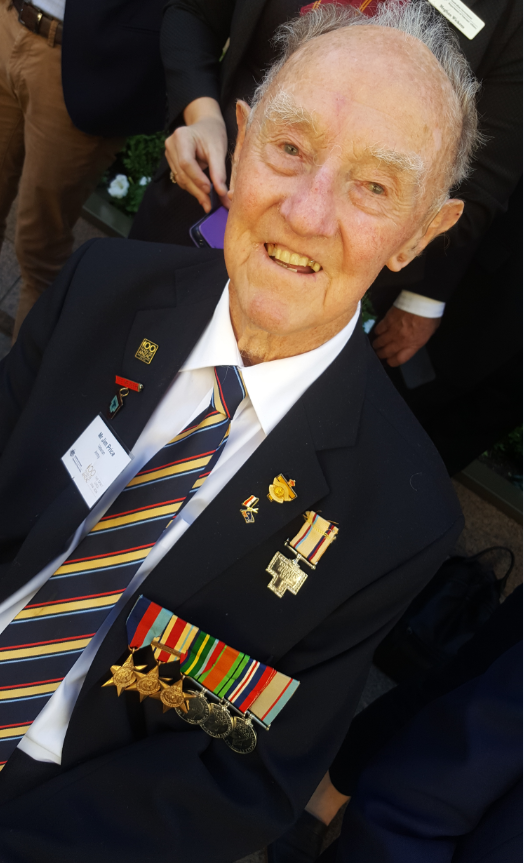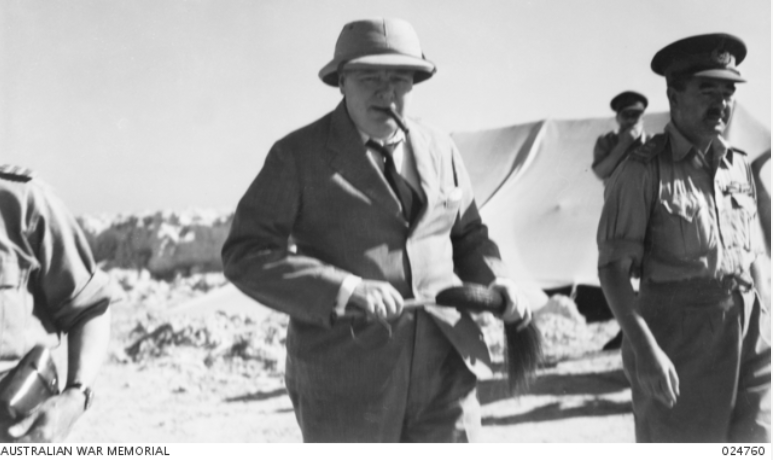Meeting 'Mr Bullfinch'

Jim Price: "I was standing over the gun checking the sight, and a bullet went between my legs and hit the tyre."
Victorian farmer Jim Price was serving with the 2/23rd Battalion when he came face-to-face with Winston Churchill at El Alamein.
“We were told Mr Bullfinch was coming to see us, you see, and we were lined up in the desert in a long line and we thought, ‘Who the heck is Mr Bullfinch?’ It was a codename, of course,” Price said.
“It was terrific ... Churchill had his V for victory, and a cigar in his mouth, and a grin on his face.
“He was just from me to you away, and one of the chaps in the 23rd who was just before me, I think, he stepped out in front of Churchill and said, ‘How about a cigar, Mr Churchill?’ And Churchill gave him a cigar.”
Price, now 96, was one of 23 veterans who visited the Australian War Memorial to commemorate the 75th anniversary of the Second Battle of El Alamein.
Named after a small railway stop in Egypt’s Western Desert, the Second Battle of El Alamein proved a watershed in the war in North Africa and significantly boosted Allied morale. Fighting began in the area in July 1942 when the British Eighth Army, which included the Australian 9th Division, managed to stop Field Marshal Erwin Rommel’s advance.
On the night of 23 October 1942, a massive artillery barrage heralded the beginning of the main Allied offensive. Allied infantry successfully captured most of their objectives, but the tanks were unable to follow through. With the Axis forces holding their lines, Lieutenant General Bernard Montgomery ordered the Australians of the 9th Division to switch their attack northward. A week of fierce fighting followed, with the Australians grinding their way over well-defended enemy positions, weakening German lines and preventing Rommel’s army from taking control of Egypt and the Suez Canal.
“It was said that before Alamein we never had a victory and after Alamein we never had a defeat. It was a turning point,” Price said.
“The night of the big battle, 1000 guns went bang. There were three searchlights pinpointed in the sky, and that was the signal for all the guns to press the trigger … We followed the tanks in, and it was noisy all right. And the light, you can imagine thousands of flashes, it was like daytime sometimes.”
Edward James Price was just 18 years old when he told the recruitment officer he was 19 so he could enlist during the Second World War.
“I enlisted in 1940 after Dunkirk,” he said. “My parents both came from Wales and England, and England was in danger of being invaded, so I thought, it’s time I went.”
Price arrived in the Middle East in late July 1941, using his leave to visit religious sites in Jerusalem and Bethlehem, and to see the places he had been taught about in Sunday School.
He went to Tobruk in August 1941 with the 26th Brigade Anti-Tank unit, and remembers being “pretty scared” on his first night there, praying to God to keep him safe.
“The worst for me at Tobruk was the shelling, especially at night time. It would go on for hours,” Price said. “We got chased by a Stuka dive bomber, me and my mate one day. He missed us, and after he’d gone past, I got my rifle and went ‘bang-bang’ after him. I felt a bit better.”
Price recalls how he would “souvenir hunt” in quiet moments behind the front lines.
“In Tobruk, there were thousands of Italian grenades lying about the place, and once we learnt to delouse them, you could take the top off and take the explosive charge out, and they were like two egg cups,” he said. “I brought them home, six of them, and they were just the right size for a boiled egg.”
In June 1942, Price transferred to the 2/23rd Battalion and in July moved to El Alamein, where the battalion was involved in fighting at Tel El Eisa. Price recalls a lucky escape during the fighting in October. He was checking one of the guns for damage when a bullet passed between his legs, puncturing the tyre on the gun mount.
“On the night of the big attack we followed in behind one of the tanks … and when we got into position – the German position had been captured an hour or so earlier – one of the boys found two Germans in a dugout, and brought them up,” Price said.
“They boys returned and suddenly I was left with the two Germans … They were both wounded, one in the leg and one in the arm, and I used my own bandages and I bandaged them up … They were setting up a first-aid station not far away, so I took them over there and there was a big line of German prisoners, and I handed them over.
“Then I joined a group being put together … to go forward. Some of the boys were in trouble up ahead, and just as we were about to move off, a sergeant picked me out … and put me in charge of an anti-tank gun crew because I’d done a lot of training around guns. [He] put me in position to dig in and wait for the German counter attack … but no attack came, and there we stuck for the rest of it – I seemed to think they’d forgotten about us.
“We got shelled that morning pretty bad. We got over to a couple of German dugouts, so I checked the gun to see if it was all right in the morning. I was standing over the gun checking the sight, and a bullet went between my legs and hit the tyre.
“I suppose it was a bit [frightening], but I didn’t think that much about it. It must have been some German who took a pot shot at me, or it was just a stray bullet.”
Price later served with the 2/23rd in New Guinea, primarily as a forward scout. He remembers being 18 miles behind Japanese lines during the landing at Red Beach north-west of Lae, and the subsequent fighting in Finschhafen. He recalls the ships being machine-gunned and three planes bombing the boats, during which ’s battalion commander was killed along with the ship’s captain and several other Australian soldiers – including one of ’s mates, Private Ed Larson.
He was discharged in May 1944. “After the New Guinea campaign ended, I got a compassionate discharge to go back on the farm because Dad was sick, and my mother had died while I was in New Guinea,” Price said.
Today, the 96-year-old still helps out on the family farm at Horsham, one or two days a week, but he will never forget the day he lined up in the desert at El Alamein to see “Mr Bullfinch”.

Winston Churchill and Lieutenant-General Sir Leslie Morshead during Churchill's visit to El Alamein.